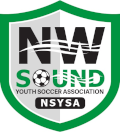
| NSYSA | |
| OYSA | |
| TOPSoccer | |
| Information | |
| Logon |
FAQ |
Guidelines for Emergency Field Situations
Current COVID protocols
WYS RTP (Washington Youth Soccer - Return To Play) Status Across Washington
Current Protocol/Safety Plan
Additionally, each NSYSA Club, and our KPSRA Referee Assoc. have additional COVID Protocols/Safety Plans associated with local play. Please read, review, and comply
What to do when the Unexpected Emergency Occurs at the Field?
Emergency medical situations at soccer fields do not happen very often, but we as coaches, assistant coaches and managers should prepare for just such an emergency like we would for any soccer practice or game. It is important when we find ourselves facing such a situation, that we remain calm and follow certain procedures to ensure the best possible medical assistance for the injured or sick individual as quickly as possible. The intent of this guideline is to go over those things that have been deemed important to ensure the best possible care for any injured or sick individual that might be at one of our soccer events.
It is important for each of you to know that each Fire Department within the District does have access to the schools and school facilities within their respective districts. Most Fire Departments know the field complexes in their areas, but may not know them by the names we use. Therefore it is important to know some other pertinent information that may be helpful to a 911 Dispatcher – such as the major cross streets and/or what part of the county you are in (i.e. Strawberry Field in Kingston area).
Every coach and team should have a process and system in place to manage medical emergencies or threats to health and safety.
U.S. SOCCER'S COMPREHENSIVE PLAYER HEALTH AND SAFETY PROGRAM covers this environmental condition, plus many others. Follow![]() this link for full details.
this link for full details.
Recommended Procedure to follow should any sort of Medical Emergency arise at a Soccer Game or Practice:
1. Stay Calm
2. Dial 911 and give the 911 Operator all the information they request. This will most likely include the following:
- Your Name
- The Nature of the Emergency – Medical
- The Location - the name and address of the field. Field address information should be obtained by you before you go to an event. This information can be obtained on the NSYSA website by clicking on the Field listed on your NSYSA Game Schedule.
- You will also be asked by the 911 Operator for the type of problem the patient is experiencing, ie. broken leg, not breathing (in lay person terms), etc. Do not get too technical unless you have medical experience.
3. Apply appropriate treatment if possible or as directed by the 911 Operator (i.e. ice to fracture).
4. Send other people to the local crossroads and entry areas to the field to help direct Emergency Personnel when they arrive.
Let Emergency Personnel know exactly where the injured person is located and let them decide how to approach the situation. Sometimes, it is easier to drive onto the field than to carry patient out, or sometimes it is easier to walk patient out depending on the situation.
5. Always have parent’s emergency signature sheets available for emergency treatment at the hospital.
Also, ensure you have all known medical information on your players and also information on how to contact your players parents or other family contact information. The injured player’s parents will need information on how to get to the hospital if not within their home area.
6. Once the injured or sick individual is receiving medical treatment, you should then notify your Soccer Club and Association so they are aware that this emergency took place and what exactly has been done.
You should always have a contact number for someone on your clubs board. If necessary, you may contact NSYSA for assistance to help you properly notify the applicable individuals within your club and/or association.
| Copyright © 2025 by Northwest Sound Youth Soccer Association/webmaster@NSYSASoccer.org |